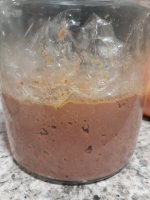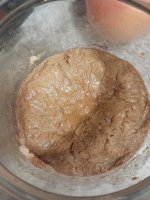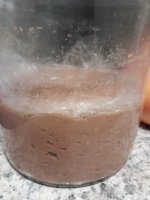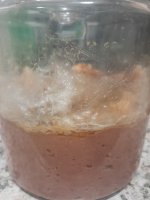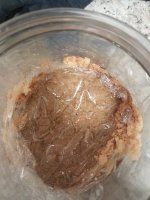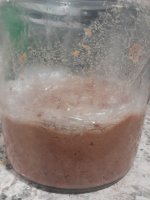As requested, a thread on garum along with my theory on using rabbit.
So garum was extensively produced during the times of the Romans and traded far and wide. The known process was to chop up fish with salt and sea water, and then let this mixture ferment in the warm/hot summer temps for 6-8 months to liquefy. The solids are strained out and the salty liquid left over is packed with ‘wow’ flavor, essentially all the glutamic and amino acids from the flesh.
This umami flavor blends with existing flavors in your foods/sauces and massively increases their complexity and satisfaction effect. You get the same type of effect today with a high quality soy or fish sauce.
The problem when making garum from other meats are the human pathogen issues. The guts of most animals breed bad stuff for humans, so traditionally fish is the only animal which you can use the guts of to do this. The guts have all the digestive enzymes and bacteria needed to break down the flesh and release the essence. Adding fish guts to a beef garum still brings across the fishy flavor, and lets face facts… fish flavor does “not” go with everything. The cheat is to use koji for the digestive enzymes and bacteria, but this also means diluting the meat out with rice. This means the ‘wow’ flavors will be diluted, and this is not what we want. All non-fish 'garum' style sauces are 'weak sauce' compared to a real fish or soy sauce.
The cheat is to use koji for the digestive enzymes and bacteria, but this also means diluting the meat out with rice. This means the ‘wow’ flavors will be diluted, and this is not what we want. All non-fish 'garum' style sauces are 'weak sauce' compared to a real fish or soy sauce.
Enter rabbits. The only concerns with rabbits are tuleremia and pneumonia type diseases, and it’s easy to spot rabbits who are sick with them because they will not be active and happy bunnies. Considering this process takes 10-12 weeks at 140F, that’s plenty of time for the rabbitry to show signs of being sick and have the batches dumped. Our rabbitry is full of healthy, happy and well kept bunnies. With this in mind, the research I've done has led me to conclude rabbit is a viable alternative to fish when making garum.
A lot of fish sauce is made at room temp, and the salt content is higher because of it. Less salt and it would putrefy and (even though it is fish) create a biological nightmare. Using heat means you can use less salt and the end sauce will be less salty. I learned from the Noma restaurant how temps of 140F are enough to keep bad bacteria from invading/thriving during the garum fermentation process. They also explained the process in detail with a few different base materials. So far I’m unable to find a single shred of info on fermenting rabbit, aside from a research paper using bacteria on meat for 18hrs to soften it.
Here’s the first jar of rabbit garum in process. It’s approximately 16% salt by weight, the rest is rabbit meat, kidneys, heart and liver, ground up with the stomach and mixed well. It’s packed in a container with plastic wrap on top of the mix to cut down exposure to oxygen.
Prepped for Heating
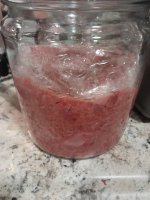
End of Day 1
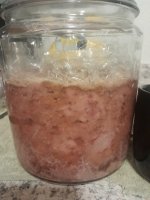
Every day during the first week, all fat must be ladled off and the remaining meat stirred thoroughly. After 24hrs, the fats have liquefied and was skimmed off the top before stirring. This is the highest volume of fats in the process. All skimming after the first day of this week was minimal.
End of Day 4
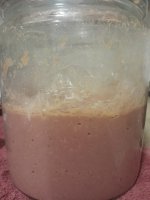
You can plainly see it has become almost like a creamed hot dog consistency. Everything broke down quickly and the change has become one of a slow color change. I'll take a pic on Tue or Wed when I ladle the fat and stir it again.
When it's finished in another 10-12 weeks, there will be a separation of solids which will float to the top. I've read the solids make a great addition to soups and other dishes, as well as a nutritious topper for dog and cat food dishes.
So garum was extensively produced during the times of the Romans and traded far and wide. The known process was to chop up fish with salt and sea water, and then let this mixture ferment in the warm/hot summer temps for 6-8 months to liquefy. The solids are strained out and the salty liquid left over is packed with ‘wow’ flavor, essentially all the glutamic and amino acids from the flesh.
This umami flavor blends with existing flavors in your foods/sauces and massively increases their complexity and satisfaction effect. You get the same type of effect today with a high quality soy or fish sauce.
The problem when making garum from other meats are the human pathogen issues. The guts of most animals breed bad stuff for humans, so traditionally fish is the only animal which you can use the guts of to do this. The guts have all the digestive enzymes and bacteria needed to break down the flesh and release the essence. Adding fish guts to a beef garum still brings across the fishy flavor, and lets face facts… fish flavor does “not” go with everything.
Enter rabbits. The only concerns with rabbits are tuleremia and pneumonia type diseases, and it’s easy to spot rabbits who are sick with them because they will not be active and happy bunnies. Considering this process takes 10-12 weeks at 140F, that’s plenty of time for the rabbitry to show signs of being sick and have the batches dumped. Our rabbitry is full of healthy, happy and well kept bunnies. With this in mind, the research I've done has led me to conclude rabbit is a viable alternative to fish when making garum.
A lot of fish sauce is made at room temp, and the salt content is higher because of it. Less salt and it would putrefy and (even though it is fish) create a biological nightmare. Using heat means you can use less salt and the end sauce will be less salty. I learned from the Noma restaurant how temps of 140F are enough to keep bad bacteria from invading/thriving during the garum fermentation process. They also explained the process in detail with a few different base materials. So far I’m unable to find a single shred of info on fermenting rabbit, aside from a research paper using bacteria on meat for 18hrs to soften it.
Here’s the first jar of rabbit garum in process. It’s approximately 16% salt by weight, the rest is rabbit meat, kidneys, heart and liver, ground up with the stomach and mixed well. It’s packed in a container with plastic wrap on top of the mix to cut down exposure to oxygen.
Prepped for Heating

End of Day 1

Every day during the first week, all fat must be ladled off and the remaining meat stirred thoroughly. After 24hrs, the fats have liquefied and was skimmed off the top before stirring. This is the highest volume of fats in the process. All skimming after the first day of this week was minimal.
End of Day 4

You can plainly see it has become almost like a creamed hot dog consistency. Everything broke down quickly and the change has become one of a slow color change. I'll take a pic on Tue or Wed when I ladle the fat and stir it again.
When it's finished in another 10-12 weeks, there will be a separation of solids which will float to the top. I've read the solids make a great addition to soups and other dishes, as well as a nutritious topper for dog and cat food dishes.

